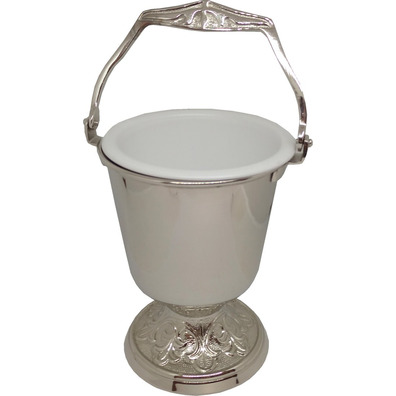Holy Water Vessel | Church Bucket | Nickel-plated color
150,00€
Taxes includedCatholic product in stock. Products ready to be shipped. You can check the approximate delivery time during the purchase process.
Holy Water Vessel | Church Bucket
- Catholic Church Holy Water Vessel.
- Made of brass.
- Nickel-plated color.
- 16 cm (6.3 in) in height without including the handle.
- 12 cm (4.72 in) in width at the mouth.
- Base of 10.5 cm (4.13 in).
- Includes an inner plastic container to prevent damage to the brass.
- Handle and base decorated with embossed elements.
- Purchase price does not include the aspergirum.
- This model of church bucket is available in gold color.
Holy Water Vessel | The Sacramental of Aspersion
The Holy Water Vessel, also known in some regions as a Catholic Church bucket, is a liturgical vessel used in the Catholic Church to hold holy water.
The Holy Water Vessel, along with the aspergirum, holds special significance during the rite of aspersion.
The aspersion is a liturgical rite within the Mass that consists of sprinkling holy water on people, objects, places, buildings, etc. During aspersion, the priest or deacon, using the Holy Water Vessel and the aspergirum, sprinkles holy water while singing hymns.
This rite has roots in the Old Testament, specifically in Psalm 51. Also known as the Miserere, this text shows how King David expressed his repentance and plea for God's forgiveness after his sin with Bathsheba.
The act of aspersion is common in parish functions. Through the use of holy water with the Holy Water Vessel and aspergirum, priests aim for various purposes.
Aspersion is a sacramental, that is, a sacred sign instituted by the Church. Sacramentals aim to prepare the faithful to receive the fruits of the sacraments.
-
Aspersion of People
The aspersion of the faithful is an act that recalls Baptism, symbolizing the purification of the soul through the forgiveness of sins. Its meaning is fulfilled in the sacrament of Baptism, inviting the faithful to renew their baptismal commitment and prepare their hearts to participate worthily in various religious activities.
-
Aspersion of Objects and Places
In addition to people, aspersion can be performed on objects or places as part of the Church’s sacramentals.
Purification and Protection
Purification and protection is one of the main objectives when a priest sprinkles holy water on an object or place. It asks God to remove all evil or profane influence while seeking divine protection.
Consecrating Spaces to God
Aspersion is performed on spaces to be consecrated or dedicated to God. The aspersion of buildings, such as churches, homes, or workplaces, consecrates those spaces for use in accordance with the Christian faith.
Blessing Catholic Objects
Finally, but not least, the blessing of sacred objects, such as crucifixes, images, or rosaries, is intended to make them instruments of authentic devotion.



